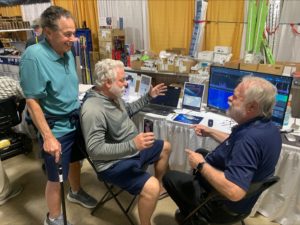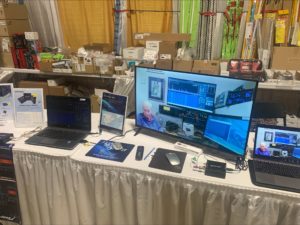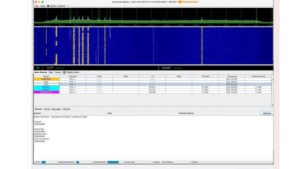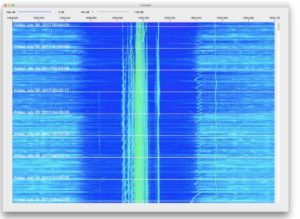Check out the latest SDRconnect video guides
We have reorganised the SDRconnect video guides with better descriptions for each of them. You can check them out here: SDRconnect Video Guides – SDRplay
We have reorganised the SDRconnect video guides with better descriptions for each of them. You can check them out here: SDRconnect Video Guides – SDRplay
Popular Aviation blogsite “Mersey Radar” have reviewed the RSP1B:
Quoting from the review “SDRplay have obviously been very busy in the past couple of years” and “Quite frankly I don’t know how SDRplay have done it for the price”
Read the whole review here: SDRPlay RSP1B SDR Receiver – Mersey Radar
Many thanks to all those who dropped by to see us at Hamcation 2024 on the HamRadio Outlet stand this weekend. We had a steady flow today (Saturday) and Steve, KI5ENW appreciated the excellent turn-out for his SDR talk. The slides can be downloaded from here: https://www.sdrplay.com/docs/Hamcation2024slides.pdf

Above: Steve, KI5ENW (right) having a lengthy discussion with a customer 😉

In this picture you see an image of the UK-based server location which was connected to one of the SDRconnect demos running at the show
There’s a lot going on to support Raspberry Pi users who are exploring radio for the first time with an SDRplay RSP.
SDRconnect SDR software runs natively on the Raspberry Pi 4 and 5. SDRconnect is really simple to use straight out of the box. That gives you a full receiver capability. There is also server software included when you install SDRconnect, allowing you to remotely access your RSP over a LAN or over the internet. SDRconnect even has a compact “Audio” mode to cope with all but the poorest of internet connections. Even then, you can still see up to 10MHz of signals in the spectrum window on the client software. Furthermore you can mix and match the platforms involved – e.g. Raspberry Pi at the server end and a Mac M1 at the client end would be just one of the many combinations possible.
When you scroll to the bottom of the SDRconnect page, simply click on the “Linux Arm 64 ” download button to get the software.
For Raspberry Pi users who are not coding experts, installing and launching new software can sometimes be tricky – so we’ve created a “Tips and Tricks” video to make the process really easy:
A hard copy document covering the same material is also available for download here: https://www.sdrplay.com/docs/RemotePiServerFinal.pdf
For Raspberry Pi users wanting to run other software – GNU Radio Companion, CubicSDR and many other RPi-based applications, then thanks to the work of of Franco Venturi, you can find supporting libraries for the RSP family on our 3rd party page: https://www.sdrplay.com/third-party/
If you’re developing software to use on a Raspberry Pi with SDRplay hardware, the up-to-date API can be downloaded from here: https://www.sdrplay.com/api/
We are grateful to the Raspberry Pi Foundation for their encouragement and support.
SDRplay will be at HamCation, Orlando, Florida on Friday February 9th to Sunday February 11th.
Come and see Steve, KI5ENW demonstrating what’s new from SDRplay, including the latest features in our multiplatform SDRconnect and server software, and the new RSP1B. Maybe you have friends visiting the show who can pick up a new RSP for you at special show rates? Otherwise it’s a great place to come and learn more about SDRs. Steve will also be giving a presentation on Saturday 10th in Room CS2 at 9.15am – covering the basics of SDRs and how they have evolved from simple dongles. More details can be found here
On Thursday 8th February, for anyone in town early, HRO will be having a special open day at their store in Orlando. They promise to offer some good deals. Steve from SDRplay will be there as well, answering questions and running SDRplay demonstrations. The address is 521 E State Rd 434 #1009, Winter Springs, FL 32708, USA.
For those interested in receiving Trunked Radio, we have some good news. Sdrtrunk is now working well with the latest SDRplay API 3.14 and the RSP1B. Author Denny has included it in his nightly build (you can get a copy from here), with a full release coming by mid February. Here’s a screenshot showing it running on an M1 Mac:

Sdrtrunk is a java application for decoding and trunk tracking multiple analog and digital radio channels across multiple SDRs or baseband recordings. The application provides local monitoring of decoded audio, recording, and streaming of audio to local and remote streaming services. Find out more about Sdrtrunk here: https://github.com/DSheirer/sdrtrunk/wiki
A trunked radio system is a two-way radio system that uses a control channel to automatically assign frequency channels to groups of user radios. You can find out more about Trunked Radio here: https://en.wikipedia.org/wiki/Trunked_radio_system
In this Video, Paul, W1VLF shows how good SDRconnect’s Diversity mode is for cancelling signals, using the dual tuner RSPduo. It is a great demonstration of how to use the additional control features provided by SDRconnect to optimise the amplitude and phase settings to maximum effect.
Black Cat Systems have something useful for Medium wave DXers. Their “Carrier Sleuth” software provides high resolution carrier waterfalls for medium wave radio stations. It runs both on Windows and MacOS.
They write ” While you can often only hear one, or perhaps two, stations on a frequency at a time, chances are there are actually many other stations lurking on that frequency, even in the daytime. Perhaps dozens. The problem is that they are too weak to notice using normal listening techniques. There’s no audio, and even their carriers are often quite weak. But by performing very high resolution FFTs (Fast Fourier Transforms) on recordings made by SDRs (Software Defined Radios) you can extract these carriers up out of the noise and see them
…SDRs are extremely useful for the MW DXer, the entire MW band can be recorded overnight, and then examined later for stations of interest. But it can be overwhelming to go through hours of SDR I/Q recording files. The usual approach is to play the recording file back through the SDR software, looking for potentially interesting signals. This process takes hours, and you still miss things……Carrier Sleuth helps you find stations of interest. “
Go to their website for detailed information on how it works and what you get: https://www.blackcatsystems.com/software/medium_wave_carrier_display_app.html

Hunt down those hidden MW DX signals with Carrier Sleuth
YouTuber TechMinds created this video review of the RSP1B and shows some of the features in SDRplay’s new SDRconnect software for Windows, MacOS and Linux/Raspberry Pi: